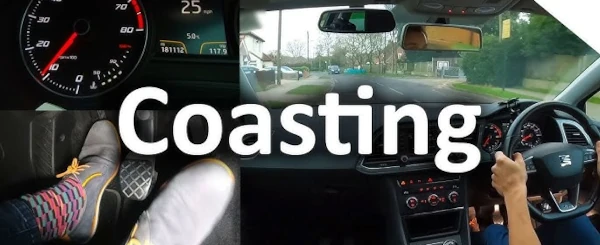 Question: I often coast down a high hill in order to save on gas if there is no traffic behind me. I notice that there is a traffic offence called: "Coast down grade illegally" on the ICBC website with a fine of $121.00 and a 2 point assessment. Is what I do coasting down grade illegally and why would that be a problem?
Question: I often coast down a high hill in order to save on gas if there is no traffic behind me. I notice that there is a traffic offence called: "Coast down grade illegally" on the ICBC website with a fine of $121.00 and a 2 point assessment. Is what I do coasting down grade illegally and why would that be a problem?
Learn to Drive Smart
The ICBC guide Learn to Drive Smart states in Chapter 5:
"It is illegal to coast downhill in neutral or with the clutch in. You need to be in gear to safely control your vehicle."

Coasting Downhill
You are correct about it being an offence. The Motor Vehicle Act says the following:
197 When travelling down grade a driver must not coast with the gears of the vehicle in neutral or the clutch disengaged.
Reasons Not To
Here are a number of reasons that I found which would indicate that this is a bad idea:
- engine braking is eliminated
- vehicle speed downhill will increase quickly
- increased use of the foot brake can reduce its effectiveness
- steering response will be affected particularly on bends and corners
- it may be more difficult to select the appropriate gear when needed.
Automatic Transmissions
My supervisor used to joke that everyone "puts it in D for dumb and drives!" You can use an automatic transmission in a setting other than D to control your speed on hills.
Share This Article
Going downhill in nautral (or clutch in) does not save gas, it actually burn more gas (although not significant amount) then going down hill with gears engaged. Unless you drive really old without electronic fuel injection. The reason for that is because engine in idle needs a minimum of fuel to keep running. while going down hill with gear engaged will for sure result in higher RPM than in idle so the EFI will detect that it does not need to inject any fuel to keep the engine running.
- Log in to post comments
The real irony, to my mind, is that our anonymous poster from six years back has also undoubtedly been wearing out his brakes far more quickly than necessary, apart from not saving on gas. And what does having anybody behind him have to do with his strange habit, I wonder?
- Log in to post comments
We used to call this "Mexican Overdrive" but I suppose that's not acceptable any more.
Back in the 60's, a friend had a DKW which was a weird beast. It had a 3 cylinder 2 stroke engine that required an oil-gas mixture to lubricate the cylinder walls, crank and rod bearings. Because the oil came in with the fuel, closing the throttle staved the engine of lubrication and it would sieze. It had a free-wheel clutch to disengage the front drive wheels if you lifted off. There was an over-ride control lever to keep the wheels engaged but doing so would sometimes cause a lock-up of the engine .... not a nice feeling at speed ... and in a corner! Can you spell S C A R Y ?
I believe that the legislation prohibiting this came from the early days of non-synchromesh manual transmissions in cars and still in heavy truck manual transmissions. If put in neutral, it could be difficult to re-engage a gear and regain control. This was especially true when they had two transmissions with a jack-shaft between them.
However, newer auto-shift transmissions in heavy trucks will slip into neutral on a slight downgrade to allow the engine to revert to about a 600 RPM idle. But it will kick the auto-throttle and re-engage if the speed climbs beyond the cruise control settings, This permits the engine braking (Jake Brakes) to kick in and foil the "bottom of the hill" radar traps. The first time it happened to me, I was a bit non-plussed to see the tach at 600 and the speedometer at about 108. It wasn't a problem as the auto-shift system slipped it back into gear at 110. It was set for a cruise at 105 and braking at 110. But since the legislation had not been updated, was it illegal? Probably .....
- Log in to post comments
Gas is effectively saved when a car is coasting downhill and it saves so much gas that is amazing. Coasting small vehicles is not dangerous as the tire friction modulates the car speed unless the downhill has a slope higher than 6%. In such case the car will increase its speed. With slopes above 8% the speed of the car greatly increases.
the engine rpms are set to around 700 when the car is idling, and you are going down hill at 100 k/h so if you multiply rpms and the amount of gas used during idling you get a number. If you are going to 1500 rpms, you are sending gas to the engine when it does not need it so the combustion becomes very inefficient.
I am upset with the post from some users here as stating that there are no gas savings is wrong. It is better to get the science right when one issues a comment. I would be ashamed about lying for gas savings when going downhill and I expect an apology for everyone on this blog or a scientific proof that what I’m stating is a lie (which is not). I have done these tests so many times in countries where is NOT illegal to coast. Here is illegal so municipalities get the 35 or 40% of your gas tax and to protect inexperienced drivers from accidents.
The story is not the same for large trucks because their weight will greatly increase their speed to the point where their brakes won’t be able to stop its momentum (momentum = speed x weight).
Car = 2,000 k * 27.8 m/s = 55,600 k /m-s
Truck = 40,000 k x 27.8 m/s = 1,112,000 k /m-s
27.8 m/s = 100 k/h.
For a car to get the same momentum of a truck it will need to travel at a speed of 2,000 k/h. Impossible right? Because at probably 300-400 k/h the car will start flying
With this blog I am not saying that you should break the law. The law is the law and must be respected. Now is this a practical law? how is it going to be enforced? May be in the modern times the cars computers can send data to the police and you can get a hefty ticket but at what point does our privacy ends?
- Log in to post comments
Gas is effectively saved when a car is coasting downhill and it saves so much gas that is amazing
How on earth would gas be saved, if you keep your foot off the accelerator? The motor only receives enough fuel to idle; the movement of the vehicle downhill cannot force the injection system to provide more. And where is your scientific 'proof' that this is/isn't the case? You won't find a qualified mechanic who would agree with you.
Coasting small vehicles is not dangerous as the tire friction modulates the car speed unless the downhill has a slope higher than 6%.
Not if there is sufficient pressure in the tires. 6% is the maximum gradient for most public highways, but the terrain in BC makes that impracticable in many places, from the lower mainland to the Coquihalla. But heck, on an 8% grade even downshifting to 2nd (on a 4-speed automatic) may not be sufficient to keep the vehicle at the speed limit. I speak from experience, this is not a belief, it's a fact.
It's also potentially dangerous as the driver cannot accelerate quickly, should it be necessary.
The law is the law and must be respected. Now is this a practical law?
It's always been my belief that the law was written at a time when vehicles typically had non-synchronized transmissions, relatively weak brakes (that could fade under hard use) and few drivers would possess the skill to double clutch the vehicle into a gear in order to keep it under control. This is also why it's prohibited to shift gears in a truck when crossing railway tracks, in case you miss a shift and become unable to maintain speed/momentum to get safely to the other side.
By always being in the best gear (not no gear) at the time, a skilled driver can make it from Vancouver to Whistler without using the brakes. But not by pushing the clutch down, or shifting to neutral!
_____________________________________________________________-
At one time, I applied for a job at a major tour bus company. Their 'driver trainer' took me out in progressively bigger buses to see if I could handle them OK. The biggest was a new Prevost with a six-speed; an odd thing to shift, as there's no 'feel' due to the lengthy connection between the shifter and the transmission several meters behind you. So you have to rely on the tachometer and the sound of the engine note to make smooth downshifts. No problem if you know what you're doing.
That 'driver trainer' was entirely happy with my driving, except that he insisted that my habit of downshifting prior to an intersection turn (in order to get into the correct gear to go through the turn and accelerate smoothly out of it) raised the sound level at the rear of the bus; he expected me to only use the brakes, with the clutch held down (effectively coasting through the turn) and then grab the gear on the way out of the intersection. So I would have got the job, only there's no way I was ever going to drive like that. I'm a professional.
(Incidentally, if I ever win the lottery, I would buy a motor coach like that to travel in. Very smooth, with a great panoramic view! Just a joy to drive on the highway.)
- Log in to post comments
I once had a 1935 Standard 10 saloon with a separate control that switched in a freewheel in the transmission so that you could coast downhill to save on fuel, to be used when you didn't need engine braking.
The engine just ticked over gently when this was in use so I find it hard to believe that fuel was not saved. The steering was not affected, and the gearlever was not moved into a different position. I guess since coasting didn't put the gearbox into neutral or use the clutch it would not have been illegal under the BC MVA.
- Log in to post comments
- Log in to post comments

Going downhill in nautral (or